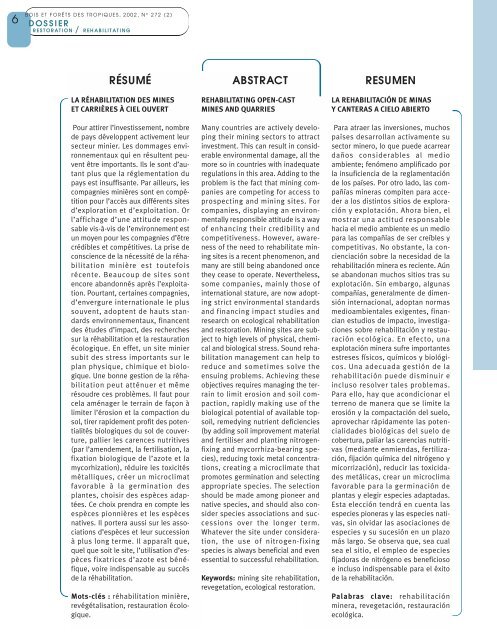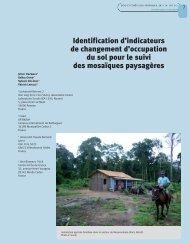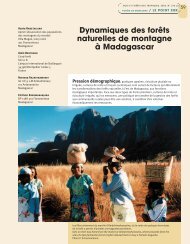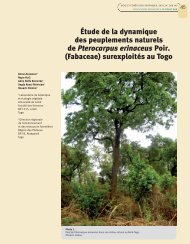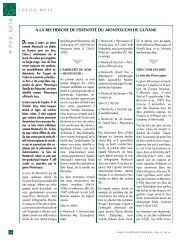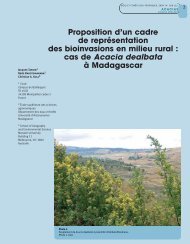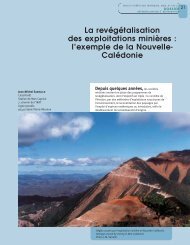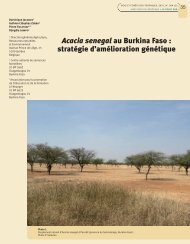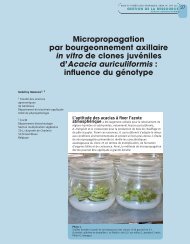La réhabilitation des mines et carrières à ciel ouvert - Bois et forêts ...
La réhabilitation des mines et carrières à ciel ouvert - Bois et forêts ...
La réhabilitation des mines et carrières à ciel ouvert - Bois et forêts ...
Create successful ePaper yourself
Turn your PDF publications into a flip-book with our unique Google optimized e-Paper software.
6BOIS ET FORÊTS DES TROPIQUES, 2002, N° 272 (2)DOSSIERRESTORATION / REHABILITATINGRÉSUMÉLA RÉHABILITATION DES MINESET CARRIÈRES À CIEL OUVERTPour attirer l’investissement, nombrede pays développent activement leursecteur minier. Les dommages environnementauxqui en résultent peuventêtre importants. Ils le sont d’autantplus que la réglementation dupays est insuffisante. Par ailleurs, lescompagnies minières sont en compétitionpour l’accès aux différents sitesd’exploration <strong>et</strong> d’exploitation. Orl’affichage d’une attitude responsablevis-<strong>à</strong>-vis de l’environnement estun moyen pour les compagnies d’êtrecrédibles <strong>et</strong> compétitives. <strong>La</strong> prise deconscience de la nécessité de la <strong>réhabilitation</strong>minière est toutefoisrécente. Beaucoup de sites sontencore abandonnés après l’exploitation.Pourtant, certaines compagnies,d’envergure internationale le plussouvent, adoptent de hauts standardsenvironnementaux, financent<strong>des</strong> étu<strong>des</strong> d’impact, <strong>des</strong> recherchessur la <strong>réhabilitation</strong> <strong>et</strong> la restaurationécologique. En eff<strong>et</strong>, un site miniersubit <strong>des</strong> stress importants sur leplan physique, chimique <strong>et</strong> biologique.Une bonne gestion de la <strong>réhabilitation</strong>peut atténuer <strong>et</strong> mêmerésoudre ces problèmes. Il faut pourcela aménager le terrain de façon <strong>à</strong>limiter l’érosion <strong>et</strong> la compaction dusol, tirer rapidement profit <strong>des</strong> potentialitésbiologiques du sol de c<strong>ouvert</strong>ure,pallier les carences nutritives(par l’amendement, la fertilisation, lafixation biologique de l’azote <strong>et</strong> lamycorhization), réduire les toxicitésmétalliques, créer un microclimatfavorable <strong>à</strong> la germination <strong>des</strong>plantes, choisir <strong>des</strong> espèces adaptées.Ce choix prendra en compte lesespèces pionnières <strong>et</strong> les espècesnatives. Il portera aussi sur les associationsd’espèces <strong>et</strong> leur succession<strong>à</strong> plus long terme. Il apparaît que,quel que soit le site, l’utilisation d’espècesfixatrices d’azote est bénéfique,voire indispensable au succèsde la <strong>réhabilitation</strong>.Mots-clés : <strong>réhabilitation</strong> minière,revégétalisation, restauration écologique.ABSTRACTREHABILITATING OPEN-CASTMINES AND QUARRIESMany countries are actively developingtheir mining sectors to attractinvestment. This can result in considerableenvironmental damage, all themore so in countries with inadequateregulations in this area. Adding to theproblem is the fact that mining companiesare comp<strong>et</strong>ing for access toprospecting and mining sites. Forcompanies, displaying an environmentallyresponsible attitude is a wayof enhancing their credibility andcomp<strong>et</strong>itiveness. However, awarenessof the need to rehabilitate miningsites is a recent phenomenon, andmany are still being abandoned onc<strong>et</strong>hey cease to operate. Nevertheless,some companies, mainly those ofinternational stature, are now adoptingstrict environmental standardsand financing impact studies andresearch on ecological rehabilitationand restoration. Mining sites are subjectto high levels of physical, chemicaland biological stress. Sound rehabilitationmanagement can help toreduce and som<strong>et</strong>imes solve theensuing problems. Achieving theseobjectives requires managing the terrainto limit erosion and soil compaction,rapidly making use of thebiological potential of available topsoil,remedying nutrient deficiencies(by adding soil improvement materialand fertiliser and planting nitrogenfixingand mycorrhiza-bearing species),reducing toxic m<strong>et</strong>al concentrations,creating a microclimate thatpromotes germination and selectingappropriate species. The selectionshould be made among pioneer andnative species, and should also considerspecies associations and successionsover the longer term.Whatever the site under consideration,the use of nitrogen-fixingspecies is always beneficial and evenessential to successful rehabilitation.Keywords: mining site rehabilitation,reveg<strong>et</strong>ation, ecological restoration.RESUMENLA REHABILITACIÓN DE MINASY CANTERAS A CIELO ABIERTOPara atraer las inversiones, muchospaíses <strong>des</strong>arrollan activamente susector minero, lo que puede acarreardaños considerables al medioambiente; fenómeno amplificado porla insuficiencia de la reglamentaciónde los países. Por otro lado, las compañíasmineras compiten para accedera los distintos sitios de exploracióny explotación. Ahora bien, elmostrar una actitud responsablehacia el medio ambiente es un mediopara las compañías de ser creíbles ycomp<strong>et</strong>itivas. No obstante, la concienciaciónsobre la necesidad de larehabilitación minera es reciente. Aúnse abandonan muchos sitios tras suexplotación. Sin embargo, algunascompañías, generalmente de dimensióninternacional, adoptan normasmedioambientales exigentes, financianestudios de impacto, investigacionessobre rehabilitación y restauraciónecológica. En efecto, unaexplotación minera sufre importantesestreses físicos, químicos y biológicos.Una adecuada gestión de larehabilitación puede disminuir eincluso resolver tales problemas.Para ello, hay que acondicionar elterreno de manera que se limite laerosión y la compactación del suelo,aprovechar rápidamente las potencialida<strong>des</strong>biológicas del suelo decobertura, paliar las carencias nutritivas(mediante enmiendas, fertilización,fijación química del nitrógeno ymicorrización), reducir las toxicida<strong>des</strong>m<strong>et</strong>álicas, crear un microclimafavorable para la germinación deplantas y elegir especies adaptadas.Esta elección tendrá en cuenta lasespecies pioneras y las especies nativas,sin olvidar las asociaciones deespecies y su sucesión en un plazomás largo. Se observa que, sea cualsea el sitio, el empleo de especiesfijadoras de nitrógeno es beneficiosoe incluso indispensable para el éxitode la rehabilitación.Palabras clave: rehabilitaciónminera, reveg<strong>et</strong>ación, restauraciónecológica.


